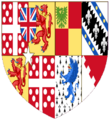Catherine Wellesley, Duchess of Wellington facts for kids
Quick facts for kids
The Duchess of Wellington
|
|
|---|---|

Engraving after a drawing by Thomas Lawrence
|
|
| Born |
Catherine Sarah Dorothea Pakenham
14 January 1773 Dublin, Ireland
|
| Died | 24 April 1831 (aged 58) Apsley House, London, England
|
| Spouse(s) | |
| Children |
|
| Parent(s) |
|
| Relatives | Hercules Langford Rowley (grandfather) |
Catherine Sarah Dorothea Wellesley, Duchess of Wellington (born Pakenham; January 14, 1773 – April 24, 1831) was also known as Kitty Pakenham before she got married. She was the wife of Arthur Wellesley, 1st Duke of Wellington, a famous general and later a prime minister.
Contents
Early Life of Catherine Pakenham
Catherine Pakenham was born in Dublin, Ireland, on January 14, 1773. Her parents were Edward Pakenham and Catherine Rowley. When her father became the 2nd Baron Longford in 1776, she gained the title "The Honourable Catherine Pakenham."
She had several brothers and sisters. Her brothers included Thomas Pakenham, 2nd Earl of Longford, General Sir Edward Pakenham, and Lieutenant-General Sir Hercules Robert Pakenham.
Catherine's Personal Life
Catherine Pakenham first met Arthur Wellesley in Ireland when they were both young. Wellesley visited her family's home in Dublin many times and showed he liked her. However, Catherine's family did not approve of their relationship at first. Wellesley was the third son in a large family and did not have much money or a clear future career at that time.
After her family said no, Wellesley focused on his military career. He was sent to places like the Netherlands and India. He became very successful and seemed to forget about Catherine. Even though she hoped they would get back together, she told a friend that she thought their chance was "over."
Catherine later got engaged to another man, Galbraith Lowry Cole. But her friend, Olivia Sparrow, told her that Wellesley still cared for her. After thinking hard, Catherine ended her engagement to Cole. She believed the stress of this decision made her unwell.
Marriage to Arthur Wellesley
When Wellesley returned to England, he asked Catherine to marry him again. She had been quite pretty and lively when he first met her. However, she had been very sick during his time away. By the time he proposed, she was thin, pale, and not in good health.
Catherine worried that Wellesley felt he had to marry her because of promises he made years ago. She wanted him to see her in person before he made a final decision. Wellesley traveled to Ireland to meet her. He was a bit disappointed by how much she had changed. But he still went ahead with the marriage.
They got married on April 10, 1806, in Dublin. Wellesley's brother, Gerald, who was a clergyman, performed the ceremony. After a short honeymoon, Wellesley went back to England. Catherine followed him, and they eventually set up their home together.
Catherine's health improved over time. However, she and Wellesley had very different personalities. Wellesley was a man of action, careful with money, and often quiet. Catherine was more protective and liked to be close to him. They did not have much in common.
They had two sons: Arthur, born in 1807, and Charles, born in 1808. They often lived apart and had separate rooms when they were together. Catherine's brother, Edward "Ned" Pakenham, served under Wellesley during the Peninsular War. Wellesley respected Ned very much, which helped his relationship with Catherine. Sadly, Ned died in 1815 at the Battle of New Orleans.
Wellesley stayed in Portugal and Spain during the entire Peninsular War. He did not return to England until 1814. Catherine focused on raising her sons and four children they adopted.
Becoming the Duchess of Wellington
Catherine became the Duchess of Wellington on May 3, 1814. This happened when Wellesley was given the title of Duke of Wellington. She later joined him in France when he became the Ambassador there. This was after Napoleon was sent away to Elba.
Some people thought Catherine's appearance did not match what they expected from an ambassador's wife or a hero's wife. However, she did very well in her role. The writer Maria Edgeworth found her "delightful" and "amiable." She said Catherine's "graceful simplicity" stood out compared to other ladies. Germaine de Staël also described Catherine as "adorable."
Her Final Days
Catherine became very ill in 1831. This brought Wellington to her side. She reached for his sleeve to see if he was still wearing a special armlet she had given him. He was. Wellington later said it was "strange" that people could live together for so long and only truly understand each other at the end. Catherine passed away on April 24, 1831.
Images for kids



